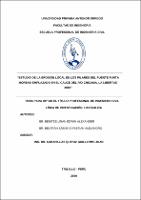Mostrar el registro sencillo del ítem
Estudio de la erosión local en los pilares del puente punta moreno emplazado en el cauce del río Chicama, la libertad 2019
| dc.contributor.advisor | Cabanillas Quiroz, Guillermo Juan | |
| dc.contributor.author | Benites Liñan, Edwin Alexander | |
| dc.contributor.author | Beltrán Sáenz, Christian Alejandro | |
| dc.creator | Benites Liñan, Edwin Alexander | |
| dc.date.accessioned | 2020-11-19T11:49:01Z | |
| dc.date.available | 2020-11-19T11:49:01Z | |
| dc.date.issued | 2020 | |
| dc.identifier.uri | https://hdl.handle.net/20.500.12759/6797 | |
| dc.description.abstract | La presente investigación realiza una estimación de la socavación local en los pilares del puente Punta Moreno, ya que tanto la acumulación de sedimento y la socavación en los pilares representan una amenaza para la sub estructura, es en este punto donde logramos identificar acumulación de sedimento en uno de los pilares que está obligando al cauce a desplazarse hacia el norte ocasionando una muy probable erosión de la rivera en el lado derecho del cauce, es inevitable el hecho de que una máxima avenida deje en muy malas condiciones este sector del emplazamiento. Por lo que es necesario conocer cómo y de qué manera se puede presentar; mediante un escenario virtual empleando modelos numéricos bidimensionales para así conocer y verificar de manera visual dicho comportamiento y así tomar decisiones en función al planteamiento de numerosas soluciones para contrarrestar estos efectos negativos. Se llevó a cabo el levantamiento topográfico del cauce del rio Chicama en el sector del emplazamiento del puente “Punta Moreno” obteniendo cotas que están en un intervalo de 403 a 504 msnm; la estimación del caudal de máxima avenida para un periodo de retorno de 500 años nos dió como resultado 4394.44 m3/s. Con el apoyo de un modelo hidráulico bidimensional calculamos el tirante máximo, con unos valores que oscilan en un rango de entre 4.33 y 5.77 m; hemos obtenido velocidades máximas representativas que se encuentran aguas abajo del puente con valores que están entre 11.45 y 13.73 m/s, en el sector del puente está entre 9.16 m/s y 11.45 m/s. Gracias a la elaboración del modelo hidráulico, concluimos que de los tres el más afectado es el pilar central, con un intervalo de 3.25 a 3.51m de profundidad para la socavación y la socavación máxima en el pilar izquierdo es de 2.99m, y en el pilar derecho alcanza un valor máximo de 1.68 m. De acuerdo a lo observado en el modelo, con respecto al transporte de sedimentos, en el sector de los pilares es mediamente fuerte, el intervalo está entre 0.06 m2/s y 0.08 m2/s. | es_PE |
| dc.description.abstract | The present investigation makes an estimate of the local undermining in the pillars of the Punta Moreno bridge, since both the accumulation of sediment and the undermining in the pillars represent a threat to the sub-structure, it is at this point that we can identify sediment accumulation in one of the pillars that is forcing the riverbed to move north causing a very probable erosion of the riverbed on the right side of the riverbed, it is inevitable that a maximum flood will leave this sector of the site in very bad conditions. So, it is necessary to know how and how it can be presented; by means of a virtual scenario using two-dimensional numerical models in order to know and visually verify said behavior and thus make decisions based on the approach of numerous solutions to counteract these negative effects. The topographic survey of the Chicama river bed was carried out in the sector of the ““Punta Moreno““ bridge site, obtaining heights in the range of 403 to 504 MASL; the estimation of the maximum flood flow for a return period of 500 years resulted in 4394.44 m3/s. With the support of a two-dimensional hydraulic model we calculated the maximum tensioner ,with values ranging from 4.33 to 5.77 m; we obtained representative maximum speeds that are located downstream of the bridge with values between 11.45 and 13.73 m/s, in the bridge sector is between 9.16 m/s and 11.45 m/s. Thanks to the elaboration of the hydraulic model, we conclude that of the three most affected is the central pillar, with an interval of 3.25 to 3.51m depth for undermining and maximum undermining in the left pillar is 2.99m, and in the right pillar reaches a maximum value of 1.68 m. According to the observed in the model, with respect to sediment transport, in the sector of the pillars is medium strong, the interval is between 0.06 m2 /s and 0.08 m2 /s. | en_US |
| dc.description.uri | Tesis | es_PE |
| dc.format | application/pdf | |
| dc.language.iso | spa | es_PE |
| dc.publisher | Universidad Privada Antenor Orrego | es_PE |
| dc.relation.ispartofseries | T_ING.CIVIL_1868 | |
| dc.rights | info:eu-repo/semantics/openAccess | es_PE |
| dc.rights.uri | https://creativecommons.org/licenses/by/4.0/ | |
| dc.source | Universidad Privada Antenor Orrego | es_PE |
| dc.source | Repositorio Institucional - UPAO | es_PE |
| dc.subject | Erosión | es_PE |
| dc.subject | Punta | es_PE |
| dc.title | Estudio de la erosión local en los pilares del puente punta moreno emplazado en el cauce del río Chicama, la libertad 2019 | es_PE |
| dc.type | info:eu-repo/semantics/bachelorThesis | es_PE |
| thesis.degree.level | Titulo Profesional | |
| thesis.degree.grantor | Universidad Privada Antenor Orrego. Facultad de Ingeniería | es_PE |
| thesis.degree.name | Ingeniero Civil | es_PE |
| thesis.degree.discipline | Ingeniería Civil | es_PE |
| dc.subject.ocde | http://purl.org/pe-repo/ocde/ford#2.01.00 | es_PE |
| renati.type | http://purl.org/pe-repo/renati/type#tesis | es_PE |
| renati.level | http://purl.org/pe-repo/renati/nivel#tituloProfesional | es_PE |
| renati.discipline | 732016 | es_PE |
| dc.publisher.country | PE | es_PE |
Ficheros en el ítem
Este ítem aparece en la(s) siguiente(s) colección(es)
-
Ingeniería Civil [1119]


